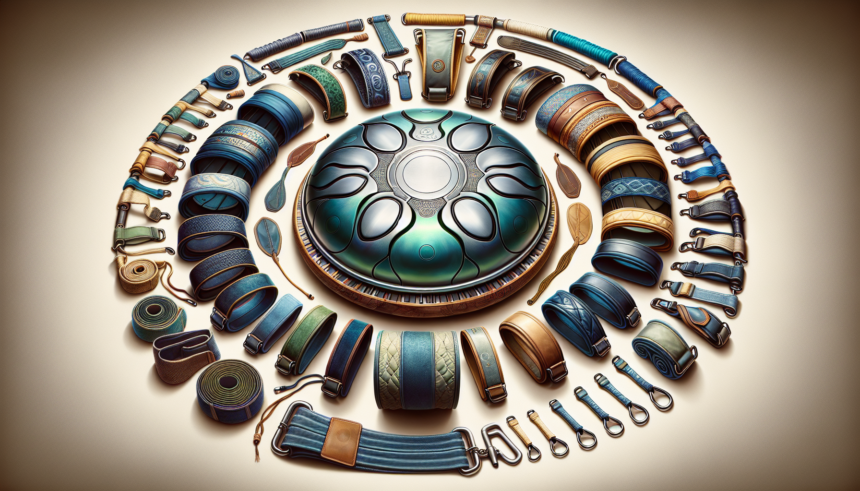The handpan, a captivating and melodious instrument, has gained immense popularity in recent years for its ethereal sound and unique design. As more musicians discover the joys of playing the handpan, the need for accessories that enhance playability and comfort has risen. One such accessory that has significantly impacted the handpan-playing experience is the handpan strap. This article explores the various benefits of handpan straps, explains how they enhance playability and comfort, and provides insights into how to choose the right strap for your needs.
The Role of Handpan Straps
Handpans, also known as hang drums or just “hangs,” are typically played while seated, with the instrument resting on the player’s legs. While this traditional setup works well for many, it can become uncomfortable during extended playing sessions or performances. This is where handpan straps come into play. Handpan straps are designed to provide additional support, allowing musicians to play standing up, move more freely, and reduce strain on their bodies.
Enhanced Mobility
One of the primary advantages of using handpan straps is the increased mobility they provide. When a handpan is securely attached to a strap, musicians can move around, switch positions, and even incorporate dance or other movements into their performance. This dynamic freedom opens up new creative possibilities, enabling players to interact with their audience in more engaging ways. Musicians can move through the crowd, take their instrument outdoors, or simply find a more comfortable posture, all without compromising their playing technique.
Improved Posture and Comfort
Sitting in one position for extended periods can lead to poor posture, back pain, and muscle strain. Handpan straps mitigate these issues by distributing the weight of the instrument more evenly across the player’s body. When played in a standing position, the weight is taken off the legs and lower back, reducing the risk of discomfort or injury. This not only encourages better posture but also makes it easier for musicians to play for longer periods without feeling fatigued. The ergonomic benefits of handpan straps are particularly valuable for musicians who perform professionally or spend long hours practicing.
Versatility in Playing Styles
Handpan straps enable musicians to experiment with a variety of playing styles and techniques. Whether you prefer playing in a seated position, standing, or even while walking, a handpan strap provides the flexibility needed to adapt to different musical contexts. This versatility can be especially advantageous during live performances, where the ability to switch between different positions can enhance the visual and auditory experience for the audience. Musicians can seamlessly transition from slow, meditative pieces to more energetic and dynamic compositions without being hindered by their instrument’s positioning.
Choosing the Right Handpan Strap
With the growing demand for handpan straps, a wide range of options has become available on the market. Selecting the right strap can make a significant difference in your playing experience. Here are some key factors to consider when choosing a handpan strap:
Material and Durability
Handpan straps are typically made from materials such as nylon, polyester, or leather. Each material has its own set of characteristics and advantages. Nylon and polyester straps are lightweight, durable, and often more affordable. Leather straps, on the other hand, offer a more premium look and feel but may require more maintenance. It’s essential to choose a strap that is sturdy and capable of supporting the weight of your instrument. Look for straps with reinforced stitching and high-quality buckles or clips for added reliability.
Adjustability
Adjustability is a crucial feature to consider when selecting a handpan strap. A strap that can be easily adjusted to various lengths ensures that you can find the perfect fit for your body and playing style. Adjustable straps allow for greater customization, making it possible to switch between standing, seated, or different playing angles effortlessly. Some straps also come with padding or additional support to enhance comfort, particularly during long playing sessions.
Attachment Mechanism
The way a handpan strap attaches to the instrument is another important factor. Some straps use hooks or clips that secure the handpan’s rim, while others may employ a harness or cradle-style attachment. Consider the type of handpan you have and how its design influences the attachment options. Ensure that the attachment mechanism is secure and does not interfere with the handpan’s resonating surfaces or sound quality.
Comfort and Ergonomics
Comfort is paramount when it comes to handpan playing, especially during extended sessions. Look for straps with padded sections or ergonomic designs that provide cushioning and support where it’s needed most. Wide straps can help distribute the weight more evenly, reducing pressure on specific points of your body. If possible, try out different straps or read user reviews to gauge the comfort and ergonomics of each option.
Conclusion
Handpan straps have revolutionized the way musicians interact with their handpans, offering enhanced playability, comfort, and creative freedom. By allowing musicians to play standing up, move around, and adopt better postures, these straps have become an essential accessory for both amateur and professional handpan players. When choosing a handpan strap, consider factors such as material, adjustability, attachment mechanism, and comfort to ensure you find the right fit for your needs. Whether you’re performing on stage, practicing at home, or exploring new playing styles, a well-designed handpan strap can make all the difference in your musical journey.
FAQs
1. Can I use a handpan strap with any type of handpan?
Yes, handpan straps are designed to be compatible with most handpans. However, it’s important to ensure that the strap you choose has an appropriate attachment mechanism that works with your specific handpan model. Some handpans have unique shapes or features that may require specialized straps.
2. Do handpan straps affect the sound quality of the instrument?
When properly attached, handpan straps should not significantly affect the sound quality of the instrument. It’s crucial to choose a strap that attaches securely without interfering with the resonating surfaces or the playing area. Always follow the manufacturer’s guidelines for attaching and using the strap to ensure optimal sound quality.
3. Are handpan straps suitable for beginners?
Yes, handpan straps are suitable for players of all skill levels, including beginners. In fact, they can be particularly beneficial for beginners by promoting better posture and reducing discomfort during practice sessions. Using a strap can make it easier for newcomers to focus on their playing technique and musical expression.
4. How do I maintain and clean my handpan strap?
The maintenance and cleaning requirements of a handpan strap depend on its material. Nylon and polyester straps can typically be wiped clean with a damp cloth. Leather straps may require more specialized care, such as using leather conditioner to keep the material supple. Always refer to the manufacturer’s care instructions to ensure the longevity of your strap.
5. Can I make my own handpan strap?
While it is possible to make your own handpan strap, it’s recommended to purchase a professionally designed strap for optimal safety and performance. Commercially available straps are specifically engineered to support the weight and structure of handpans, ensuring secure attachment and comfort. If you choose to make your own, be sure to use high-quality materials and test the strap thoroughly before use.





